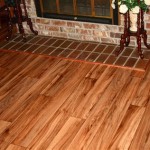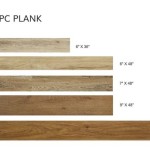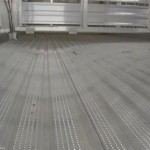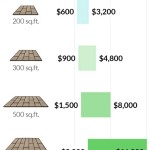Nailing Wood Flooring: A Comprehensive Guide
Nailing wood flooring is a traditional and effective method for securing solid hardwood planks to a subfloor. This process, when executed correctly, results in a durable, stable, and aesthetically pleasing floor. The success of a nailed wood floor depends on several factors, including proper preparation, selecting the right tools and materials, and employing the appropriate nailing techniques. This article provides a comprehensive overview of the nailing process, covering essential considerations for achieving professional-quality results.
Before embarking on the nailing process, careful assessment of the subfloor is paramount. The subfloor must be structurally sound, level, and clean. Any inconsistencies or defects in the subfloor will translate into problems with the finished wood floor. A warped or uneven subfloor will result in an uneven floor with potential for squeaking and instability. The subfloor materials generally consist of either plywood or oriented strand board (OSB). Verify the subfloor does not exist over concrete without necessary moisture barriers.
Thorough cleaning is essential to remove debris, dust, and any other contaminants that could interfere with the adhesion of the wood flooring. Vacuuming the subfloor is a suitable first step, followed by a more detailed sweep. The subfloor must remain dry before, during, and after the installation process. Testing for moisture content is critical to prevent future problems with the wood flooring. Ideally, both the subfloor and wood flooring material should be acclimated to the installation environment for several days prior to installation. This process minimizes expansion and contraction issues and increases the chances of successful installation.
Selecting the appropriate tools and materials ensures efficient and effective execution of the nailing process. These tools significantly impact the quality and longevity of the installed floor.
Essential Tools for Nailing Wood Flooring
A power nailer is the cornerstone of hardwood floor installation. Power nailers, operated by compressed air, drive nails quickly and consistently into the wood flooring. There are two main types: pneumatic nailers and cleat nailers. Pneumatic nailers, designed for standard nails, work well for thinner wood flooring. Cleat nailers, specifically designed for tongue-and-groove flooring, drive specialized cleats at an angle through the tongue of the board. Cleat nailers create a more secure hold and reduce the risk of splitting the wood. The pressure of the air compressor needs to be calibrated for the wood density and thickness of the floorboards.
In addition to a power nailer, a rubber mallet provides controlled force for seating the flooring planks tightly together. The mallet is used in conjunction with a tapping block to prevent damage to the edges of the flooring during the seating process. A tapping block is generally made of a dense plastic or hardwood and distributes the impact force evenly. The rubber mallet and tapping block work together to protect the tongue and groove of the board.
A moisture meter plays a vital role in determining the moisture content of both the subfloor and the wood flooring. Accurate moisture readings help prevent problems associated with expansion and contraction after installation. Excessively high moisture levels can lead to warping, cupping, and other forms of damage. The moisture meter assists in verifying that both materials are within the acceptable range for installation, which is usually between 6% and 9% for wood flooring and no more than 12% for the subfloor.
A circular saw, preferably with a fine-tooth blade, allows for precise cutting of the wood flooring to fit around walls, doorways, and other obstacles. A miter saw enhances the accuracy of angle cuts and is beneficial for installing borders or intricate patterns. Accurate measurements, often obtained with a tape measure and square, support accurate cuts and prevent costly mistakes.
A pry bar is a useful tool for maneuvering flooring planks into tight spaces, especially near walls and other obstructions. It also assists in removing damaged planks during repairs. Eye protection and hearing protection are personal protective equipment (PPE) to maintain safe working conditions.
Finally, choosing the right type and size of nails is crucial. The length of the nails should be sufficient to penetrate the subfloor securely, typically reaching at least 1 to 1.5 inches. When using a pneumatic nailer, flooring nails with barbs or rings provide enhanced holding power. With a cleat nailer, use the cleat specifically designed for it. The nail size depends on the thickness of the wood flooring. Thicker flooring requires longer and heavier-gauge nails.
Nailing Techniques for Optimal Floor Installation
The precise nailing technique is the determining factor for the stability and appearance of the finished wood flooring. Correct alignment, spacing, and nailing angle are all crucial elements.
Beginning the installation with a straight starter row establishes a solid foundation for the rest of the floor. The first row of planks is often face-nailed, meaning that nails are driven directly through the surface of the plank. This method provides immediate and secure fastening. The face-nailed planks should then be covered with baseboards to conceal the nail holes. A chalk line serves as a useful tool for maintaining a straight line and ensuring that the first row is accurately aligned along the wall. Maintain a consistent gap between the starter row and the wall to allow for expansion and contraction.
Subsequent rows of planks are typically nailed through the tongue at a 45-degree angle using a power nailer. This hidden nailing method leaves the surface of the floor free from visible nail holes, resulting in a cleaner, more aesthetically pleasing appearance. Position the nailer correctly to ensure that the nail penetrates the tongue without splitting it. Maintaining consistent nail spacing, usually every 6 to 8 inches, across the length of the planks provides uniform holding power. Near the end of each plank, placing a nail 2 to 3 inches from the end prevents the board from lifting, especially when installing longer pieces.
Employing a consistent pattern of nail placement is important for maintaining structural integrity. Stagger the end joints of the flooring planks to prevent seams that run continuously across the floor. This staggering can be achieved by using varying lengths of planks and cutting planks to the appropriate size. The spacing should be at least twice the width of the planks to minimize the risk of movement and potential separation.
When encountering obstacles, such as doorways or pipes, precise measurements and cuts are required. Carefully measure the dimensions of the obstruction and transfer these measurements onto the flooring plank. Use a saw to make the necessary cuts, ensuring a snug fit around the obstacle. In these areas, face-nailing may be necessary to secure the planks adequately.
Occasionally, the nailer may not seat the nails flush with the surface of the wood. A nail set tool can remedy this issue by tapping the nail head until it is slightly below the surface. This tool prevents damage to the surrounding wood and ensures a uniform appearance. Alternatively, nail heads that protrude too far can be removed using a nail puller or pliers. Be careful not to damage the surrounding wood when removing these nails.
Addressing Common Issues and Troubleshooting
Despite careful planning and execution, several issues can arise during the nailing process. Understanding these potential problems and knowing how to address them is essential for achieving a successful outcome.
One common problem is splitting the tongue of the wood flooring while nailing. This issue often occurs when the nailer's pressure is set too high, the wood is excessively dry, or the nails are too large. Reduce the air pressure of the nailer and ensure that the flooring is properly acclimated to the environment before installation. Pre-drilling pilot holes can help mitigate the risk of splitting in particularly brittle or dense wood.
Another frequently encountered issue is squeaking floors. Squeaks typically occur when the wood flooring rubs against the subfloor due to inadequate fastening or movement. To address squeaks, identify the location of the sound and reinforce the area with additional nails or screws. Shim the subfloor from underneath to eliminate gaps between the floor and the subfloor. Apply powdered graphite between the planks to reduce friction and minimize the squeaking noise.
If gapping between the planks occurs after installation, it is usually the result of expansion and contraction due to changes in humidity. Maintaining consistent humidity levels in the building can help prevent this problem. Consider installing a humidifier or dehumidifier to control the moisture content in the air. Fill small gaps with color-matched wood filler and apply a coat of finish to blend the repair with the surrounding floor.
Loose or popping nails can also present challenges. This issue often occurs when the nails have failed to engage properly with the subfloor. Replace loose or popping nails with longer nails or screws for a more secure hold. Apply construction adhesive beneath the affected area to prevent further movement before re-nailing.
Uneven surfaces or raised edges can also affect the finished floor. These issues usually arise from an irregular subfloor or improper alignment during installation. Use a floor sander to level out high spots and ensure a smooth transition between planks. Apply a leveling compound to the subfloor before installation to correct any imperfections or uneven areas.
Installing wood flooring requires diligent attention to detail and adherence to best practices. By carefully preparing the subfloor, selecting the right tools and materials, employing proper nailing techniques, and addressing potential issues effectively, the homeowner can achieve a beautiful and durable wood floor.

Floating Floor Vs Nail Down Slaughterbeck Floors Inc

Advantages Of Nail Down Floor Installation Wood Fitting

How To Install Hardwood Flooring Young House Love

How To Install Hardwood Flooring Young House Love

Hardwood Nailed Over Ecowarm Radiantboard

Is Nail Down Installation The Best Unique Wood Floor

Which Method Should I Use To Install My Engineered Wood Floor Tesoro Woods
What Is The Blind Nailing Of A Hardwood Floor Quora

Hardwood Floor Installation Instructions Nail Down

Floating Floor Vs Nail Down Slaughterbeck Floors Inc
Related Posts








